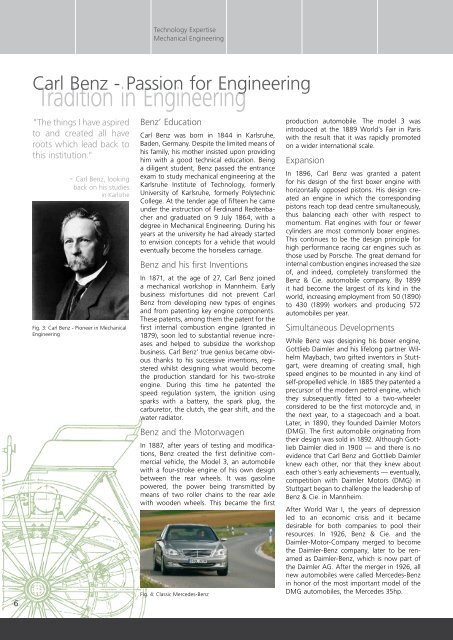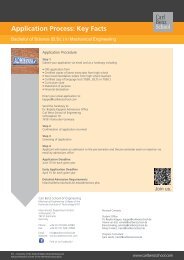International Bachelor Program in Mechanical Engineering
International Bachelor Program in Mechanical Engineering
International Bachelor Program in Mechanical Engineering
Create successful ePaper yourself
Turn your PDF publications into a flip-book with our unique Google optimized e-Paper software.
6<br />
Carl Benz - Passion for Eng<strong>in</strong>eer<strong>in</strong>g<br />
Tradition <strong>in</strong> Eng<strong>in</strong>eer<strong>in</strong>g<br />
"The th<strong>in</strong>gs I have aspired<br />
to and created all have<br />
roots which lead back to<br />
this <strong>in</strong>stitution."<br />
- Carl Benz, look<strong>in</strong>g<br />
back on his studies<br />
<strong>in</strong> Karlsrhe<br />
Fig. 3: Carl Benz - Pioneer <strong>in</strong> <strong>Mechanical</strong><br />
Eng<strong>in</strong>eer<strong>in</strong>g<br />
Technology Expertise<br />
<strong>Mechanical</strong> Eng<strong>in</strong>eer<strong>in</strong>g<br />
Benz’ Education<br />
Carl Benz was born <strong>in</strong> 1844 <strong>in</strong> Karlsruhe,<br />
Baden, Germany. Despite the limited means of<br />
his family, his mother <strong>in</strong>sisted upon provid<strong>in</strong>g<br />
him with a good technical education. Be<strong>in</strong>g<br />
a diligent student, Benz passed the entrance<br />
exam to study mechanical eng<strong>in</strong>eer<strong>in</strong>g at the<br />
Karlsruhe Institute of Technology, formerly<br />
University of Karlsruhe, formerly Polytechnic<br />
College. At the tender age of fifteen he came<br />
under the <strong>in</strong>struction of Ferd<strong>in</strong>and Redtenbacher<br />
and graduated on 9 July 1864, with a<br />
degree <strong>in</strong> <strong>Mechanical</strong> Eng<strong>in</strong>eer<strong>in</strong>g. Dur<strong>in</strong>g his<br />
years at the university he had already started<br />
to envision concepts for a vehicle that would<br />
eventually become the horseless carriage.<br />
Benz and his first Inventions<br />
In 1871, at the age of 27, Carl Benz jo<strong>in</strong>ed<br />
a mechanical workshop <strong>in</strong> Mannheim. Early<br />
bus<strong>in</strong>ess misfortunes did not prevent Carl<br />
Benz from develop<strong>in</strong>g new types of eng<strong>in</strong>es<br />
and from patent<strong>in</strong>g key eng<strong>in</strong>e components.<br />
These patents, among them the patent for the<br />
first <strong>in</strong>ternal combustion eng<strong>in</strong>e (granted <strong>in</strong><br />
1879), soon led to substantial revenue <strong>in</strong>creases<br />
and helped to subsidize the workshop<br />
bus<strong>in</strong>ess. Carl Benz’ true genius became obvious<br />
thanks to his successive <strong>in</strong>ventions, registered<br />
whilst design<strong>in</strong>g what would become<br />
the production standard for his two-stroke<br />
eng<strong>in</strong>e. Dur<strong>in</strong>g this time he patented the<br />
speed regulation system, the ignition us<strong>in</strong>g<br />
sparks with a battery, the spark plug, the<br />
carburetor, the clutch, the gear shift, and the<br />
water radiator.<br />
Benz and the Motorwagen<br />
In 1887, after years of test<strong>in</strong>g and modifications,<br />
Benz created the first def<strong>in</strong>itive commercial<br />
vehicle, the Model 3, an automobile<br />
with a four-stroke eng<strong>in</strong>e of his own design<br />
between the rear wheels. It was gasol<strong>in</strong>e<br />
powered, the power be<strong>in</strong>g transmitted by<br />
means of two roller cha<strong>in</strong>s to the rear axle<br />
with wooden wheels. This became the first<br />
Fig. 4: Classic Mercedes-Benz<br />
production automobile. The model 3 was<br />
<strong>in</strong>troduced at the 1889 World’s Fair <strong>in</strong> Paris<br />
with the result that it was rapidly promoted<br />
on a wider <strong>in</strong>ternational scale.<br />
Expansion<br />
In 1896, Carl Benz was granted a patent<br />
for his design of the first boxer eng<strong>in</strong>e with<br />
horizontally opposed pistons. His design created<br />
an eng<strong>in</strong>e <strong>in</strong> which the correspond<strong>in</strong>g<br />
pistons reach top dead centre simultaneously,<br />
thus balanc<strong>in</strong>g each other with respect to<br />
momentum. Flat eng<strong>in</strong>es with four or fewer<br />
cyl<strong>in</strong>ders are most commonly boxer eng<strong>in</strong>es.<br />
This cont<strong>in</strong>ues to be the design pr<strong>in</strong>ciple for<br />
high performance rac<strong>in</strong>g car eng<strong>in</strong>es such as<br />
those used by Porsche. The great demand for<br />
<strong>in</strong>ternal combustion eng<strong>in</strong>es <strong>in</strong>creased the size<br />
of, and <strong>in</strong>deed, completely transformed the<br />
Benz & Cie. automobile company. By 1899<br />
it had become the largest of its k<strong>in</strong>d <strong>in</strong> the<br />
world, <strong>in</strong>creas<strong>in</strong>g employment from 50 (1890)<br />
to 430 (1899) workers and produc<strong>in</strong>g 572<br />
automobiles per year.<br />
Simultaneous Developments<br />
While Benz was design<strong>in</strong>g his boxer eng<strong>in</strong>e,<br />
Gottlieb Daimler and his lifelong partner Wilhelm<br />
Maybach, two gifted <strong>in</strong>ventors <strong>in</strong> Stuttgart,<br />
were dream<strong>in</strong>g of creat<strong>in</strong>g small, high<br />
speed eng<strong>in</strong>es to be mounted <strong>in</strong> any k<strong>in</strong>d of<br />
self-propelled vehicle. In 1885 they patented a<br />
precursor of the modern petrol eng<strong>in</strong>e, which<br />
they subsequently fitted to a two-wheeler<br />
considered to be the first motorcycle and, <strong>in</strong><br />
the next year, to a stagecoach and a boat.<br />
Later, <strong>in</strong> 1890, they founded Daimler Motors<br />
(DMG). The first automobile orig<strong>in</strong>at<strong>in</strong>g from<br />
their design was sold <strong>in</strong> 1892. Although Gottlieb<br />
Daimler died <strong>in</strong> 1900 — and there is no<br />
evidence that Carl Benz and Gottlieb Daimler<br />
knew each other, nor that they knew about<br />
each other‘s early achievements — eventually,<br />
competition with Daimler Motors (DMG) <strong>in</strong><br />
Stuttgart began to challenge the leadership of<br />
Benz & Cie. <strong>in</strong> Mannheim.<br />
After World War I, the years of depression<br />
led to an economic crisis and it became<br />
desirable for both companies to pool their<br />
resources. In 1926, Benz & Cie. and the<br />
Daimler-Motor-Company merged to become<br />
the Daimler-Benz company, later to be renamed<br />
as Daimler-Benz, which is now part of<br />
the Daimler AG. After the merger <strong>in</strong> 1926, all<br />
new automobiles were called Mercedes-Benz<br />
<strong>in</strong> honor of the most important model of the<br />
DMG automobiles, the Mercedes 35hp.







